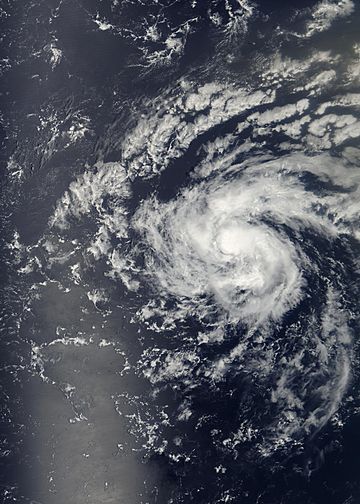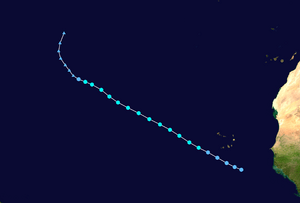Tropical Storm Debby (2006) facts for kids
| Tropical storm (SSHWS/NWS) | |

Tropical Storm Debby on August 24, 2006.
|
|
| Formed | August 21, 2006 |
|---|---|
| Dissipated | August 26, 2006 |
| Highest winds | 1-minute sustained: 50 mph (85 km/h) |
| Lowest pressure | 999 mbar (hPa); 29.5 inHg |
| Damage | None |
| Areas affected | Cape Verde |
| Part of the 2006 Atlantic hurricane season | |
Tropical Storm Debby was the fifth tropical storm of the 2006 Atlantic hurricane season. Debby formed just off the coast of Africa on August 21 from a tropical wave. After passing near the Cape Verde islands, Debby moved generally northwestward for much of its life, reaching a peak intensity of 50 mph (85 km/h). Strong wind shear weakened the storm, and Debby dissipated on August 27 over the northern Atlantic Ocean.
Early in its life, Debby was forecasted to pass through the southern Cape Verde islands as a tropical storm, possibly causing life-threatening flooding. Most computer models consistently predicted Debby to move to the northwest throughout its lifetime, though intensity was more of a problem for forecasters. The National Hurricane Center continually predicted Debby to strengthen into hurricane status, though strong vertical shear eventually prevented the storm from becoming a hurricane.
Storm history
A strong tropical wave moved off the coast of Africa late on August 20, and almost convective banding and a broad circulation. A large area of low pressure formed within the wave the next day while located 260 miles southeast of the Cape Verde islands. Though convection decreased early on August 21, the area of low pressure stayed well-organized and the system developed into Tropical Depression Four late on August 21. Water temperatures remained warm enough for development, while upper level shear was minimal as the depression moved west-northwestward because of a ridge of high pressure to its north. Original predictions by the National Hurricane Center also forecasted a turn to the northwest based computer model predictions, as quoted by forecaster James Franklin, "The models have also been excellently wrong thus far".
In spite of a decrease in convection shortly after forming, the large depression remained well organized, with a 575 mile wide wind field. On August 22, as it passed 140 miles (225 km) miles to south of the Cape Verde islands, deep convection developed over the center of circulation, and early on August 23 the depression strengthened into Tropical Storm Debby about 300 miles southwest of Cape Verde. Banding features continued to organize as the system slowly strengthened, and on August 23 Debby reached its peak intensity of 50 mph over the open waters of the Atlantic Ocean. Forecasters predicted Debby to continue to strengthen to reach hurricane status, while its projected path placed the storm in an area of warm water temperatures and moderate upper level shear.
Shortly after reaching its peak intensity, Debby encountered an area of dry air, and as a result weakened. The low level circulation detached itself from the dying convection while the system as a whole continued west-northwestward. Convection redeveloped over a portion of the center, while banding features redeveloped as well. Organization continued, and Debby again reached its peak intensity of 50 mph on August 24. Southerly wind shear displaced the convection to the north of the center, and Debby weakened to a weak tropical storm on August 25. The center of the storm became asymmetric and elongated, and on August 26 Debby weakened to a tropical depression. Convection remained minimal and it quickly degenerated into a remnant area of low pressure. The low turned to the north and north-northeast ahead of an approaching trough, and on August 28 the low dissipated.
Preparation and Impact
The government of the Cape Verde islands gave out tropical storm warnings at the same time with the issuance of the first advisory on Tropical Depression Four, meaning tropical storm conditions were expected in the area within 24 hours. The National Hurricane Center stated that heavy rainfall, possibly as high as 10 inches in mountainous areas, would be possible in the territory, possibly causing life-threatening flash floods and mudslides.
However, because of a reformation further to the south, tropical storm warnings were discontinued as the depression passed away from the area. While passing around 115 miles to the southwest of the southwestern most islands, the depression produced a 35 mph wind gust at Fogo and some rainfall, though no damage was reported.
Long range forecasts brought the storm near Bermuda. However Debby remained over 900 miles from the island at its closest approach.
Though the storm was forecasted to remain far away from the Gulf of Mexico, investors tracking the storm caused the price of crude oil to rise 60 cents a barrel due to the possible impact to oil installations.
Related pages
|
Tropical cyclones of the 2006 Atlantic hurricane season |
||||||||||||||||||||||||||
|
|
|||||||||||||||||||||||||
|
|
||||||||||||||||||||||||||
See also
 In Spanish: Tormenta tropical Debby (2006) para niños
In Spanish: Tormenta tropical Debby (2006) para niños



